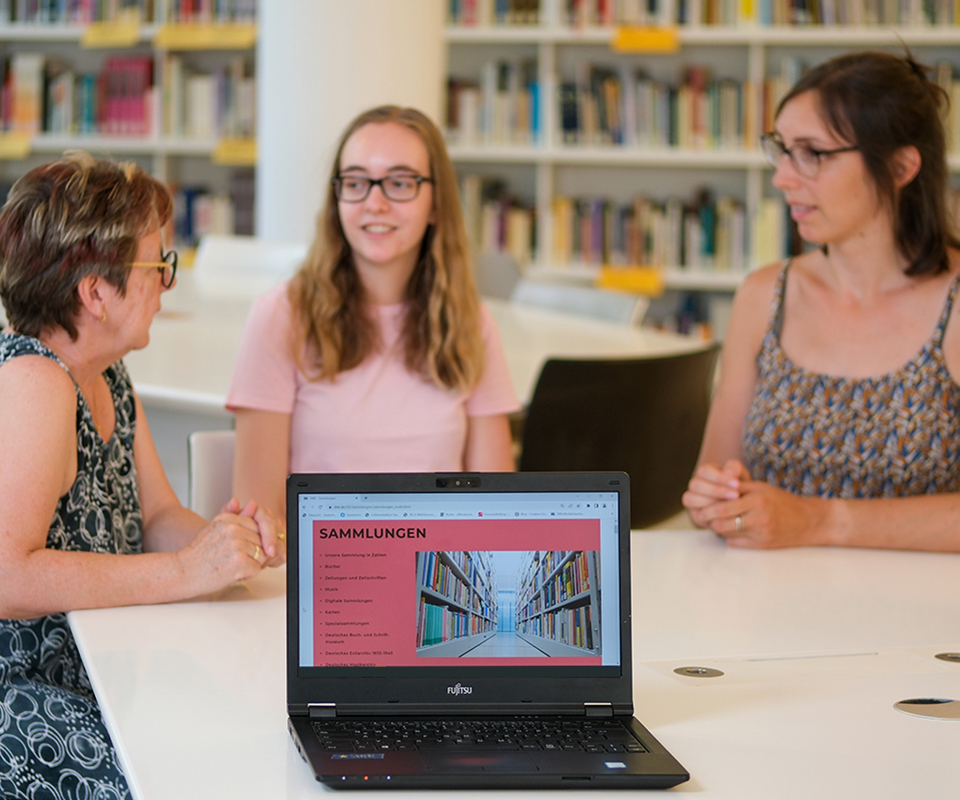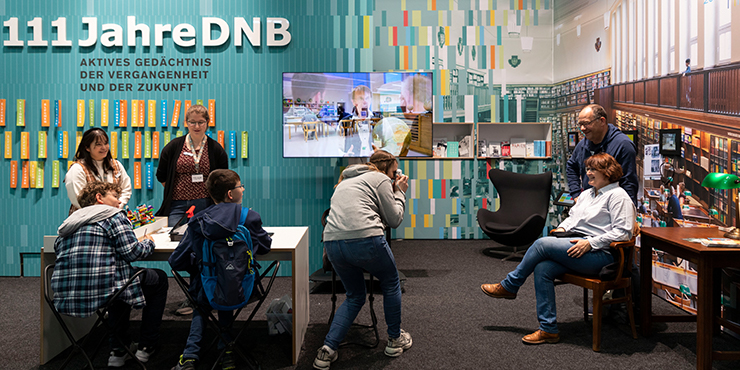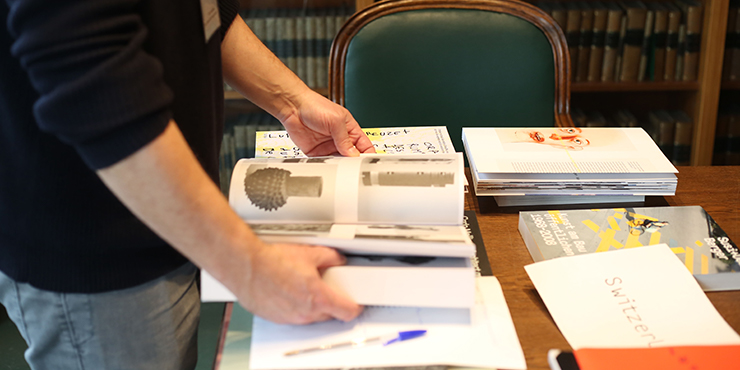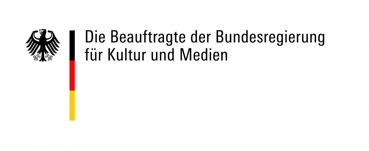Presenting Collections Digitally
 Photo: Stephan Jockel
Photo: Stephan Jockel
DH Aktivitäten: UPdate from the digital treasure trove
DH, also known as "digital humanities", are a relatively new scientific discipline which is steadily gaining in importance as digitisation becomes more widespread. The German National Library is following this development attentively and is involved at various levels – not least as an archive of holdings. It accordingly offers its data holdings and digital collections for scientific and research purposes and for experimental and creative work. The DNB continued to support the digital humanities by means of calls and fellowships in 2023.
DH-Call
In 2023, a call for DH proposals was successfully issued for the fourth time. The DNB publishes this annual request for proposals with the aim of assisting with scientific and research projects. It is specifically directed at researchers who wish to use copyright-protected holdings in their projects and supports them by providing metadata, digital objects and infrastructures. The provisions in section 60d UrhG apply. It is also possible to have a limited volume of analogue objects digitised. The following projects were approved as part of the DH call for 2023:
- Dominik Dungel (Leipzig University): Neomodalität versus Erneuerung? Fragen zu Stilbildung und Instrumentalisierung von Kirchenmusik in den 1920er und -30er Jahren aus wissenssoziologischer Perspektive.
- Berenike Herrmann and Daniel Kababgi (both Bielefeld University): descSpace – Untersuchung des diachronen Wandels von Ort- und Raumbeschreibungen in der Prosa-Literatur von 1800 bis heute.
- Elena Mayer (Leipzig University): Konflikte in der autonomen Frauenbewegung.
- Jana-Katharina Mende (University Halle): Code-Switching codieren: Mehrsprachige Literatur digital annotieren und analysieren (1820–1920).
DH fellowships
The DH fellowships, an addition to the services offered in the field of digital humanities, were awarded for the second time in 2023. These are mainly intended for early career scientists and offer them the opportunity to carry out their own research project using the DNB's open access data. The fellows receive a monthly allowance to cover their living expenses, are assigned project mentors from the DNB who support them as they work on their projects, and receive assistance when the time comes to make their research findings visible. Networking with other fellows and data experts is also guaranteed. Four project ideas were selected in 2023 and presented at an inaugural workshop in Frankfurt in August 2023:
- Janna Kienbaum: Mehr als die Summe ihrer Teile – Durch die Verbindung von Datensilos zur Erforschung der Judaica in der DNB.
- Philipp Köbe: Medizin & Gesundheit in der Science-Fiction Literatur: eine maschinelle Datenanalyse.
- Can-Elliot Sachs: Ab wann zeigt sich ein Umweltbewusstsein in der deutschen Publikationslandschaft des Datenkorpus der DNB?
- Benjamin Schnabel: Extraktion fehlender Entitäten mittels Natural Language Processing zur Ergänzung von Daten im Bereich der Judaistik.
DNBLab – Usability of digital resources expanded still further
DNBLab: the main hub for the presentation, access and re-use of digital resources. Interested users have been able to obtain data, open-access digital objects and full texts as downloads and through various interfaces since 2020. Online coding tutorials show how this works and provide a basic introduction to machine-based data processing and analysis. DNBLab also offers various practical case studies for browsing as well as regular virtual introductory sessions that explain the various areas of the lab – questions are more than welcome! In 2023, DNBLab was expanded and given a still more professional character.
Besides continuing to develop the services offered, particular attention was paid to publicity and networking. Teaching partnerships were expanded and new educational formats tried out for interactive introductory events. Following a successful DNBLab workshop at BiblioCon 2023, further practically oriented events took place at seminars and congresses. Many interested visitors were addressed and contacts established at a stand set up at the Historians' Congress in Leipzig.
Networking was also the order of the day at the meetings of German-language library labs, with sessions allowing exchanges of expertise on working with Jupyter Notebooks, audio analysis and the use of AI in libraries. Here DNBLab actively seeks dialogue with colleagues and experiments with various ways to support lab users.
Promoting more intensive use
In response to the community feedback received during the events, access to the DNBLab website has been simplified and additions are constantly being made to the data sets on offer. Additional information, e.g. on choosing suitable supply channels, has also been added to the handouts provided to help users work with the data. Another helpful innovation: an overview of the MARC21-xml data fields relevant to researchers sorted by data instead of field numbers.
Increasing numbers of inspiring practical examples
The collection of practical case studies (applications and scripts) on working with the data is growing, due for example to the publication of research findings from the projects supported through the DH calls and DH fellowships. Moreover, 2023 saw three students on the Master's degree course in Cultural Data Studies at the MCDCI (Marburg Center for Digital Culture and Infrastructure) in Marburg complete part of their internship at the DNB in DNBLab. They had the opportunity to use the Jupyter Notebooks available in the lab to create their own scripts for sub-projects. These enabled them to answer self-selected questions using DNB data.
The idea of expanding DNBLab to allow users to work with copyright-protected data in the DNB reading rooms has been pursued from the outset and is being driven further. Existing corpora and standardised tools are for example being examined with an eye to the potential provision of a prototype for text and data mining in the reading rooms.
ZDB in WorldCat: 2 million bibliographic data records imported
The world's largest bibliographic database for serial publications supervised by an editorial team? Today, this is the German Union Catalogue of Serials (ZDB), which is the result of joint efforts by numerous institutions – by no means only libraries – and contains bibliographic and holdings data from some 3,880 facilities.
All the cooperatively generated bibliographic data and the majority of the ZDB's holdings data are copyright-free and available free of charge (CC0 1.0). With its metadata, the ZDB serves as a data hub and facilitates the provision of a wide range of data-related services.
Since 2023, the DNB has been effecting the central delivery of ZDB metadata to WorldCat on behalf of the ZDB as a "trusted partner". WorldCat is the world's biggest bibliographic catalogue database. As part of a joint project, more than 2 million bibliographic data records and a large part of the ownership information have been imported into WorldCat, where they are continually updated.
Go to the German Union Catalogue of Serials
Olschwanger & more: Digital exile testimonies
An exciting new addition to the virtual exhibition platform "Arts in Exile": the special exhibition "Robert Hans Olschwanger. Caricaturist in Exile" is online! Interested visitors will now find a selection of works and documents from the extensive estate left by the commercial artist and caricaturist. The Europeana portal can also report numerous additions from the German National Library's Exile Archive, among them the impressive images recorded by photographer Eric Schaal.
A first punches Adolf Hitler right in the face, making him stagger backwards. The drawing clearly shows that the blow was a powerful one. The word "invasion" is written on the arm that delivered the punch. And the caricaturist also tells us when it took place, i.e. on 6 June 1944. This image shows the landing of the Western Allies in Normandy. D-Day marked the beginning of Europe's liberation from Nazi tyranny.
“24 war criminals tried in court. But what about the rest?”
SChange of scene: 24 men fenced in by barbed wire are visible at the bottom left of the picture. Clearly identifiable in the front row: Hermann Göring, Commander-in-Chief of the Luftwaffe and Reich Minister of Economics, next to him on the right Rudolf Hess, Adolf Hitler's deputy, Robert Ley, Reich Organisation Leader of the NSDAP, and Julius Streicher, publisher of the Nazi smear sheet “Der Stürmer”. The top third of the image shows a huge crowd of men. The crowd is so large it cannot be quantified. The uniforms worn by the men clearly identify them as Nazis. “SE JUZCA A 24 DELINCUENTES DE GUERRA. Y A LOS DEMAS …?”, the caricaturist asks, appalled
The image shows the 24 most prominent war criminals on trial, 21 of whom sat in the dock during the Nuremberg Trials in 1945/46.
Olschwanger in Peru after occupational ban
The drawings are the work of Jewish caricaturist and graphic designer Robert Hans Olschwanger (1905-1998). He started out in the 1920s by working for the “Frankfurter Zeitung”. In 1935, the National Socialists banned him from practising his profession. In 1939, he emigrated to Peru, from where he provided commentaries on global political events for the most important Peruvian daily newspapers, earning himself a reputation as a caricaturist who wielded an acerbic pen. Not until political unrest broke out in Peru at the end of the 1960s did the artist return to Germany with his family. After settling in Cologne in 1970, he continued working as a commercial artist and caricaturist until well into the 1990s. On 21 January 2023, the special exhibition “Robert Hans Olschwanger. Caricaturist in Exile“ went online on the virtual exhibition platform “Arts in Exile”.
Since 2021, the artist's extensive estate has been held by the German National Library's German Exile Archive 1933–1945. It comprises more than 1,100 drawings, caricatures and commercial graphics as well as personal documents and the typescript of a ballad composed by Olschwanger in the 1970s. A selection of works and documents from this rich legacy can now be viewed online for the first time as part of the special exhibition on “Arts in Exile”.
Digitised objects from the Exile Archive available in the Europeana portal
The impressive images captured by photographer Eric Schaal have been available in digital format on the virtual platform Europeana since 2023. Schaal fled to the USA in 1936; his artistic legacy is preserved in the Exile Archive. Along with Schaal's works, the digitised items from the estate of writer Leo Perutz, the Exile Archive's eyewitness interviews and editions of the Digital Exile Press are now part of Europeana, where they are encountering new contexts.
Click here to go to the virtual special exhibition “Robert Hans Olschwanger. Caricaturist in Exile”.
Here you will find the virtual platform Europeana, which hosts the estate of writer Leo Perutz, die Exile Archive's eyewitness interviews and the Digital Exile Press.
More transparency: new look for the HTML version of JOP services
A direct link to the full text: this is probably something that every online researcher dreams of. In ideal circumstances, the availability research platform Journals Online & Print (JOP) can make this dream come true. JOP is a free web service offered by the German Union Catalogue of Serials (ZDB) and Electronic Journal Library (EZB). After more than twenty years, the design of the HTML version of JOP has been completely revamped with an optimised display and extended functions.
But what exactly can JOP do? The linking resolver can be used to determine whether a specific journal or journal article is available online or in print at any given institution. This is where both the EZB and the ZDB come in. Open access (OA) information can also be retrieved from Unpaywall or BASE (Bielefeld Academic Search Engine) through the EZB. In ideal circumstances, the online resources deliver a direct link to a full text. Institutions can directly integrate the availability information obtained through JOP into their databases and special portals. The corresponding data are delivered in various formats for this purpose.
Information at a glance
In 2023, the design of the HTML version of JOP was completely revamped and the display optimised and extended. The icons used were modified slightly, firstly because the icon differentiation (filled/unfilled) was previously not perceived, secondly because the icon representing a text did not cover all the resource types available locally in the ZDB.
Displays of availability information have been made more transparent and repetitions of information have been dispensed with whenever possible. This means that resource titles which have more than one record at an institution are only displayed once, while the availability information is clearly assigned to the respective title. An example is provided in the following screenshots.
 Availability display before the HTML version of JOP was redesigned
DNB
Availability display before the HTML version of JOP was redesigned
DNB
 Availability display after the HTML version of JOP was redesigned
DNB
Availability display after the HTML version of JOP was redesigned
DNB
In the new design, the menu bar is no longer positioned above the availability information but is now accessed through a burger icon. This opens up more space for the availability information. The following illustration shows the open menu on a page containing availability information.
 Navigation menu in new HTML output
DNB
Navigation menu in new HTML output
DNB
It goes without saying that the new design of the HTML version is responsive. The availability information can thus be adequately displayed in different sizes on various end devices.
Improved functions
Besides changing the design of the HTML version, a number of improvements were made with regard to content and function:
- For some years now, the JOP service has also been tracking availability at libraries which maintain their resources exclusively in the ZDB. The new version has now given these libraries additional open access information. If the requesting library has no inventory record in the ZDB, the JOP service checks whether availability can be tracked through the EZB.
- If a title is found, the URL in the ZDB catalogue no longer refers the user to the appropriate library data record but rather to the detailed bibliographic information. This is because the information in the data record is already extensively mapped by the JOP information service. In contrast, the detailed bibliographic data furnish JOP users with additional information, since JOP itself only contains a summary of information on the respective title.
- In the HTML version, the rubric "Availability at other institutions" also displays libraries that participate exclusively in EZB as well as libraries that participate in both EZB and ZDB. The addition of ZDB libraries holding the respective items is planned for the future.
You can find more information about the JOP-Service here.
Click here to go to the article on the second service offered jointly by the EZB and ZBD – the EZB-ZDB Data Service.
Last changes:
04.06.2024






